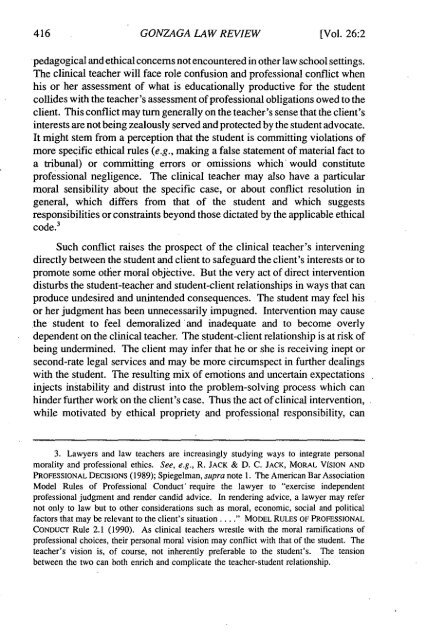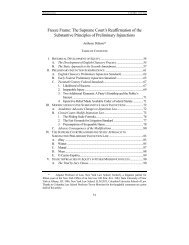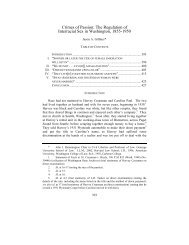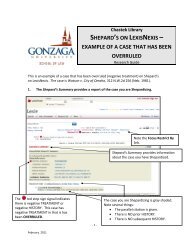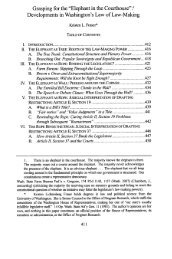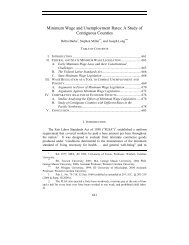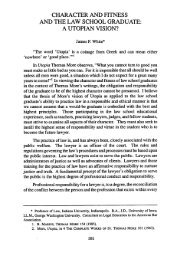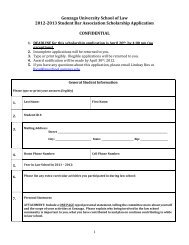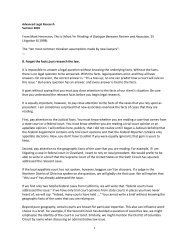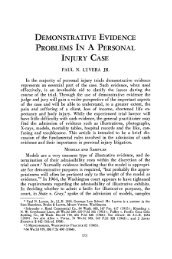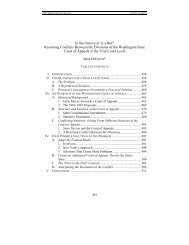professional responsibility, student practice, and the clinical
professional responsibility, student practice, and the clinical
professional responsibility, student practice, and the clinical
You also want an ePaper? Increase the reach of your titles
YUMPU automatically turns print PDFs into web optimized ePapers that Google loves.
416 GONZAGA LAW REVIEW<br />
[Vol. 26:2<br />
pedagogical <strong>and</strong> ethical concerns not encountered in o<strong>the</strong>r law school settings.<br />
The <strong>clinical</strong> teacher will face role confusion <strong>and</strong> <strong>professional</strong> conflict when<br />
his or her assessment of what is educationally productive for <strong>the</strong> <strong>student</strong><br />
collides with <strong>the</strong> teacher's assessment of <strong>professional</strong> obligations owed to <strong>the</strong><br />
client. This conflict may turn generally on <strong>the</strong> teacher's sense that <strong>the</strong> client's<br />
interests are not being zealously served <strong>and</strong> protected by <strong>the</strong> <strong>student</strong> advocate.<br />
It might stem from a perception that <strong>the</strong> <strong>student</strong> is committing violations of<br />
more specific ethical rules (e.g., making a false statement of material fact to<br />
a tribunal) or committing errors or omissions which would constitute<br />
<strong>professional</strong> negligence. The <strong>clinical</strong> teacher may also have a particular<br />
moral sensibility about <strong>the</strong> specific case, or about conflict resolution in<br />
general, which differs from that of <strong>the</strong> <strong>student</strong> <strong>and</strong> which suggests<br />
responsibilities or constraints beyond those dictated by <strong>the</strong> applicable ethical<br />
code. 3 Such conflict raises <strong>the</strong> prospect of <strong>the</strong> <strong>clinical</strong> teacher's intervening<br />
directly between <strong>the</strong> <strong>student</strong> <strong>and</strong> client to safeguard <strong>the</strong> client's interests or to<br />
promote some o<strong>the</strong>r moral objective. But <strong>the</strong> very act of direct intervention<br />
disturbs <strong>the</strong> <strong>student</strong>-teacher <strong>and</strong> <strong>student</strong>-client relationships in ways that can<br />
produce undesired <strong>and</strong> unintended consequences. The <strong>student</strong> may feel his<br />
or her judgment has been unnecessarily impugned. Intervention may cause<br />
<strong>the</strong> <strong>student</strong> to feel demoralized <strong>and</strong> inadequate <strong>and</strong> to become overly<br />
dependent on <strong>the</strong> <strong>clinical</strong> teacher. The <strong>student</strong>-client relationship is at risk of<br />
being undermined. The client may infer that he or she is receiving inept or<br />
second-rate legal services <strong>and</strong> may be more circumspect in fur<strong>the</strong>r dealings<br />
with <strong>the</strong> <strong>student</strong>. The resulting mix of emotions <strong>and</strong> uncertain expectations<br />
injects instability <strong>and</strong> distrust into <strong>the</strong> problem-solving process which can<br />
hinder fur<strong>the</strong>r work on <strong>the</strong> client's case. Thus <strong>the</strong> act of <strong>clinical</strong> intervention,<br />
while motivated by ethical propriety <strong>and</strong> <strong>professional</strong> <strong>responsibility</strong>, can<br />
3. Lawyers <strong>and</strong> law teachers are increasingly studying ways to integrate personal<br />
morality <strong>and</strong> <strong>professional</strong> ethics. See, e.g., R. JACK & D. C. JACK, MORAL VISION AND<br />
PROFESSIONAL DECISIONS (1989); Spiegelman, supra note 1. The American Bar Association<br />
Model Rules of Professional Conduct' require <strong>the</strong> lawyer to "exercise independent<br />
<strong>professional</strong> judgment <strong>and</strong> render c<strong>and</strong>id advice. In rendering advice, a lawyer may refer<br />
not only to law but to o<strong>the</strong>r considerations such as moral, economic, social <strong>and</strong> political<br />
factors that may be relevant to <strong>the</strong> client's situation .. " MODEL RULES OF PROFESSIONAL<br />
CONDUCT Rule 2.1 (1990). As <strong>clinical</strong> teachers wrestle with <strong>the</strong> moral ramifications of<br />
<strong>professional</strong> choices, <strong>the</strong>ir personal moral vision may conflict with that of <strong>the</strong> <strong>student</strong>. The<br />
teacher's vision is, of course, not inherently preferable to <strong>the</strong> <strong>student</strong>'s. The tension<br />
between <strong>the</strong> two can both enrich <strong>and</strong> complicate <strong>the</strong> teacher-<strong>student</strong> relationship.


